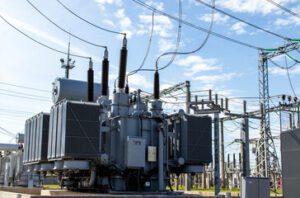What is a Busbar?
A busbar is a metallic conductor that serves as a central hub for multiple electrical connections. It can be solid, hollow, or flexible, and comes in various shapes. In this blog, we will understand the Types of Busbars and their roles in respective applications.
Essentially, it’s an electrical junction where all incoming and outgoing electrical currents converge. This means that a busbar collects electrical power in one place. The number of incoming and outgoing connections can be adjusted based on power requirements, always considering the busbar’s current carrying capacity. Busbars are integral components of substations, used in Low Voltage (up to 400V), Medium Voltage (around 11kV), and High Voltage (up to 765kV and beyond) systems.
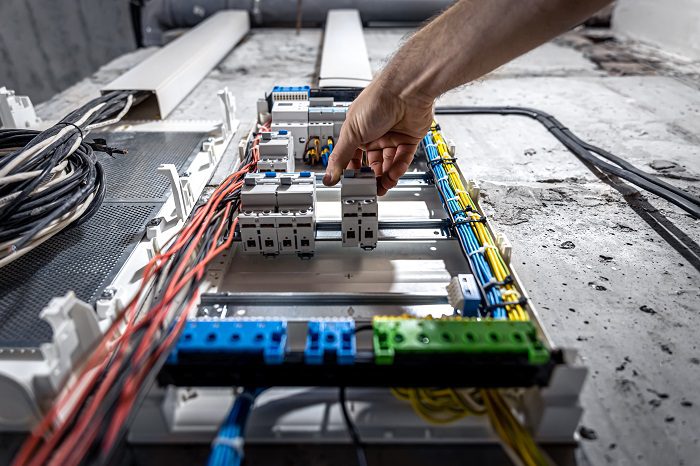
Role of Busbar in Electrical Power Distribution
Busbars, simplify complex power distributions, making them more affordable by replacing multiple conductors and reducing costs.
By providing a single node point, it is easier to add protection to all incoming and outgoing connections based on busbar connection schemes. A Busbar system includes isolators and circuit breakers. When a fault occurs, the circuit breaker trips and the faulty busbar section is disconnected from the circuit.
The choice of busbar arrangement depends on factors like reliability, flexibility, and cost. Key considerations include ease of maintenance, continuity during maintenance, and economical installation.

Busbar Schemes
Busbars are often left without dedicated protection due to the belief in their high reliability. Additionally, it was previously assumed that backup protection would suffice in providing adequate busbar protection. However, issues such as load loss and extended fault clearance times when using backup protection have necessitated the need for a dedicated busbar protection scheme. Here are some of the main busbar schemes:
A) Single Bus-Bar Arrangement

This arrangement uses two busbars and a bus coupler to connect isolating switches and circuit breakers to the busbar. It allows load transfer from one bus to another in case of overloading. This scheme maintains supply continuity even during faults, allowing maintenance without disrupting continuity. However, the use of two busbars increases system costs.
B) Main and Transfer Bus Arrangement
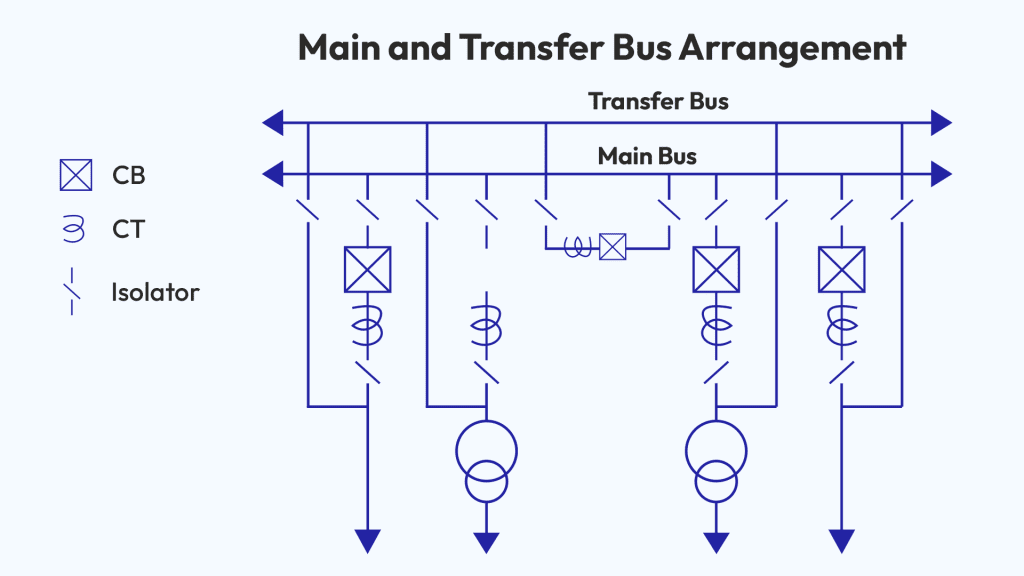
This arrangement uses two busbars and a bus coupler to connect isolating switches and circuit breakers to the busbar. It allows for load transfer from one bus to another in case of overloading. It maintains supply continuity even during faults, and maintenance can be done without disrupting continuity. However, the use of two busbars increases system costs.
C) Double Bus Double Breaker Arrangement
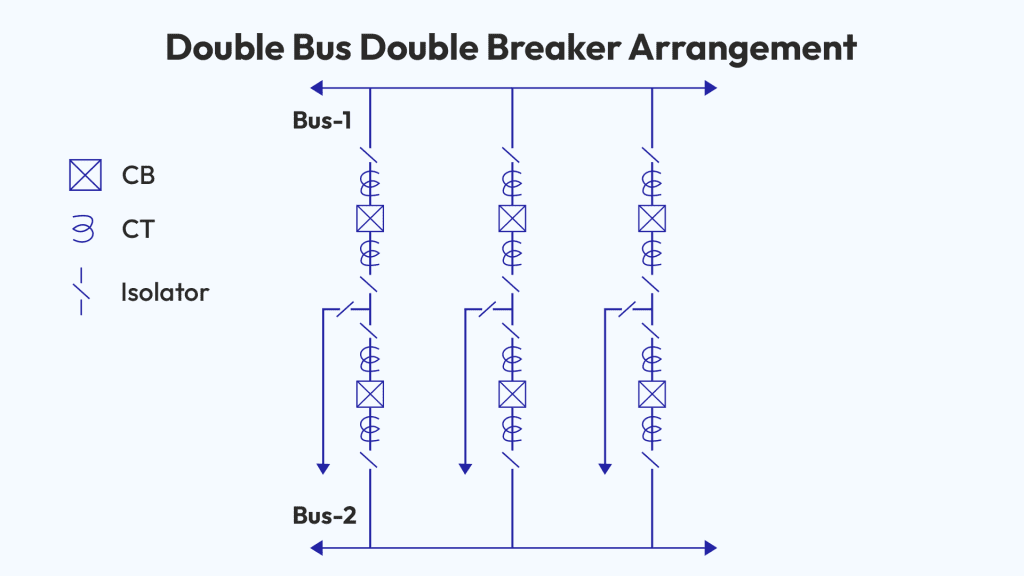
Featuring two busbars and two circuit breakers, this scheme excels in reliability and flexibility. It ensures an uninterrupted supply during faults and maintenance, but this advantage comes at a higher cost due to the additional equipment.
D) One-and-a-Half Breaker Arrangement

This setup involves three circuit breakers for two independent circuits. Each circuit shares a common centre circuit breaker. This arrangement ensures protection against supply loss and facilitates the easy addition of extra circuits making it easy to maintain. However, maintenance costs can be higher with this arrangement.
E) Ring Main Arrangement
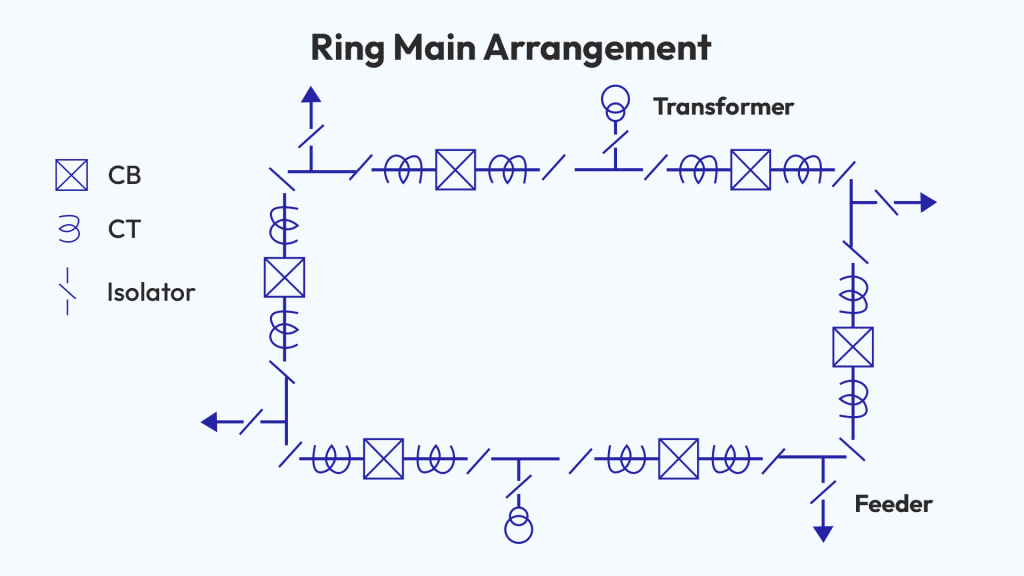
In this arrangement, the busbar forms a ring, offering two supply paths. This means if one circuit experiences issues, the system can still operate through the other section of the ring. This design localizes faults to specific sections, and allows maintenance of a circuit breaker without interrupting the entire supply. But this arrangement can’t be extended in future as it is a closed-circuit system. Therefore, it is not the best option for developing systems.
Application of Busbars
Busbars are a crucial component in a wide range of electrical systems, from small power systems to large substations and power generation systems. Here are some of the key areas where busbars are extensively used:
1) Power Plants: In power plants, busbars are used to distribute the generated power to the transformers, which then transmit the electricity to the grid. They are essential for managing the flow of electricity and ensuring efficient power distribution.
2) Substations: Substations are intermediary points in the power grid where voltage levels are transformed from high to low or vice versa. Busbars in substations help distribute power to various feeders. They also play a crucial role in fault management by allowing faulty sections to be isolated without disrupting the entire system.
3) Data Centers: In data centres, busbars are used to distribute power to various servers and other equipment. They offer a flexible and efficient solution for managing the high power requirements of these facilities.
4) Hospitals: Hospitals have critical power needs, and any disruption can have serious consequences. Busbars in hospitals ensure reliable and efficient power distribution to all areas, including critical ones like operating rooms and intensive care units.
5) Institutions: Educational institutions, office buildings, and other large facilities use busbars for efficient power distribution across the premises. They help manage the diverse power requirements of different sections, from classrooms and offices to cafeterias and labs.
6) Apartments: In residential buildings, busbars are used in the main distribution board to distribute power to individual apartments or sections of the building. They help manage the power load and ensure safety by allowing faulty sections to be isolated.
7) Metros and Railways: In transportation systems like metros and railways, busbars are used in power substations to distribute electricity to the tracks and trains. They are crucial for the smooth operation of these transportation systems.
In essence, busbars are used wherever there’s a need for efficient, reliable, and flexible power distribution. They help manage power loads, ensure safety, and reduce costs by replacing multiple conductors with a single busbar. The choice between copper and aluminium busbars depends on specific requirements, including electrical ratings, cost, weight, and environmental considerations.
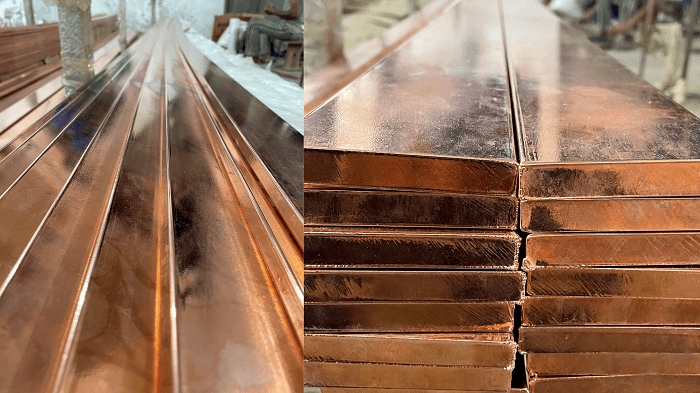
Types of Busbars
Busbars come in several shapes, including rectangular, cross-sectional, and round. The two primary materials used in their construction are copper and aluminum. Deciding between these 2 types of Busbars depends on various factors, let’s explore them.
Copper vs Aluminum Busbars
Busbars, which are metallic conductors serving as a central hub for multiple electrical connections, can be made from various materials. However, the two most common materials are copper and aluminum. Both have their unique advantages and disadvantages, and the choice between the two often depends on the specific requirements of your project.
Copper Busbars
Copper is known for its high conductivity, and has been a go-to metal for applications requiring excellent ductility and conductivity. It has better tensile strength, higher thermal expansion, and superior conductivity as compared to aluminium.
Aluminum Busbars
The strength and conductivity of aluminium varies depending on the alloying agents used. Its characteristics range from being extremely soft to having a strength like mild steel. The conductivity of pure aluminium is 62% compared to copper but Aluminum is up to 70% lighter. This can lead to cost savings in areas like transportation and installation. However, aluminium requires more surface area for conductivity than copper, meaning that aluminium components are larger..
Copper VS Aluminum Busbars
When it comes to electrical ratings, copper outperforms aluminium in terms of power loss, voltage drop, electrical resistance, and ampacity. However, if the comparison is based on weight, aluminium is more efficient. In terms of cost, copper is significantly more expensive than aluminium. However, both materials’ prices are greatly influenced by political, economic factors, and consumer demand, leading to price volatility.
From an environmental perspective, both copper and aluminium are recyclable metals. However, aluminium is the most recycled, with approximately 75% of all produced aluminium still in use. The recycling process for aluminium also uses less energy compared to copper, making it arguably more environmentally sustainable.
In terms of connectors, if you choose to use aluminium, the connectors must be rated for aluminium. Those rated for aluminium can often be used with copper, but the reverse isn’t always the case.
In conclusion, the choice between copper and aluminium busbars depends on various factors, including electrical ratings, cost, environmental sustainability, and connector compatibility. Understanding these factors can help you make an informed decision for your next busbar application.
Conclusion – Why do we need them?
As busbars provide a single platform for the connection of many circuits, these are used to cut the costs of the system. As Aluminum and copper are extensively used in all electrical systems, busbar systems provide cost-cutting by minimizing/optimizing the use of copper and aluminium.
Thank you for reading the blog, Axis is a leading manufacturer and supplier of Electrical Components to over 80+ Countries. To get a quote or to talk to our industry expert visit our contact us section. You can also watch our videos by our experts – click here.



